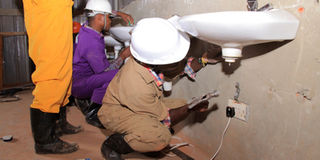Who should do rental repair and maintenance?

The responsibility to fix issues such as plumbing problems result in contention if not spelled out properly in the tenant agreement. PHOTO BY RACHEL MABALA
One of the most contentious issues between landlords and tenants, according to Vincent Watu, a property manager, is the handling of repairs.
He notes that with time as tenants occupy properties, some damage will occur not necessarily out of abuse or neglect but just the expected wear and tear.
“A landlord should be responsible for gradual damage such as worn carpets, minor scuffs and scrapes on the walls. These are things that are difficult to avoid when someone has occupied the property for several months and years,” Watu advises.
When tenant is to blame
He says however, sometimes tenants do cause an unacceptable level of damage to furniture, fixtures and fittings which they are liable for.
“Damage caused by a tenant is something different. This is damage that does not happen naturally but is committed on purpose, by accident or through neglect that affects the normal function or usefulness of the property.
Examples of tenant damage can include anything from a broken toilet seat to a smashed mirror, missing door handles, holes or dents in walls,” he says.
Intentional Vs accidental
Abdu Ogola, a real estate agent, however, notes that determining damage that occurred naturally and that which is intentional can be a very contentious issue and to avoid this, both tenants and landlords should have a detailed and accurate inventory preferably photographic which is useful in avoiding disputes over damage when time comes.
“The day you move into the property, take photos all the furniture, fixtures, fittings, paintwork, walls and flooring. Any existing damage or wear should be carefully recorded, and both you and your tenants should sign the inventory to confirm you agree with it.
Then, when your tenants move out, do another walk-through inspection with your tenants to document any changes to the condition of your property, noting any discrepancies and taking pictures as evidence. If you spot anything that you believe should be classed as tenant damage rather than wear and tear, explain why you will be taking deductions from the deposit,” he advises.
As long as the damage has been caused by tenant abuse or neglect rather than simple wear and tear, and providing you have all the necessary evidence that the damage occurred during their tenancy, you should be able to successfully claim the amount from the tenants deposit.
Tenant Agreement
When drawing a tenant agreement, according to Henry Kyarimpa, a lawyer, it should be clear on what maintenance the tenant is responsible for and what the landlord is responsible for.
“Discuss these repairs with the tenant in advance to avoid legal disputes. Your landlord must keep the structure of the building in perfect condition including floors, roofs and plumbing system, among others,” Kyarimpa says.
If your landlord fails to address a major problem, you have options such as seeking legal counsel.
The lawyer notes that the landlord is compelled to make repairs depending on the nature of the problem.
“There are some problems that are annoying such as leaking faucets, old paint or stained tiles but these are considered cosmetic repairs which are not legally required, unless the tenant agreement says so,” says the lawyer.




